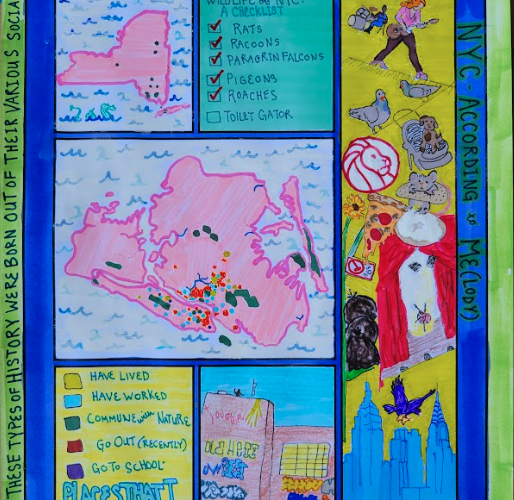Class information
725; 325 – Advanced Curriculum Development in World History and Global Education for Urban Contexts, Grades 7-12
20 students
Designed for future teachers in New York City public schools, this course covers effective social studies teaching for all learners. Students explore the necessary pedagogical balance between teaching historical content knowledge and teaching skills that promote, among other things, successful historical reading, writing, and critical thinking. Attention is given to an appreciation of the world’s diversity and the use of multiple sources to enrich historical understanding. Students examine the teaching of global history and geography from various angles and strive to describe and apply curricular and pedagogical approaches that are effective, relevant, and engaging for our students.
Project overview
One-pagers are concise yet imaginative responses to a text or set of texts. Originally developed by AVID, a college readiness program for youth, this response method has now been used by educators across subject areas. In a one-pager, my students will synthesize their responses to a prompt and assigned texts on a single graphic organizer.
Students’ one-pager should respond to this prompt:
What is your map of the world? In reflecting on traditional maps of your city (or cities), state(s), nation(s), and world, what do you want to emphasize? What places are critical for you? What sites might belong on your world map that wouldn’t appear on a conventional Google Map? How might you re-draw or re-conceive a map of the world?
Students will pick one one-pager format (see Materials below) to hand-illustrate their response.
Their one-pager should include:
- A sketch of a map that is important to you. Provide a title for this map.
- An explanation of how mapping relates to your life. You can write it out, make a word cluster, or even draw it.
- Illustrate or collage 2-3 relevant images.
- Create a border using a key phrase from Week 2’s readings.
- Use color to bring your one-pager to life.
Why did you select this project? How does it relate to identity and purpose?
I designed this project because I wanted to include more community building and personal sharing in my course. Over eight semesters, I tended to focus mainly on curriculum design skills and theory. I wanted to allow students to share who they are, where they come from, and the lenses through which they see the world.
I was also vested in using the cartographic metaphor–“remapping”–to drive the big ideas of the course. Maps are spatial and temporal representations of what is important. In invoking this concept of remapping, I aimed for students to look outside the traditional, Eurocentric approaches to teaching world history. I wanted them to teach histories outside of world wars, heroic figures, conquest, and Enlightenment-style thinking.
In the vein of Walter Benjamin and Situationist wanderers, the assignment asks students to forgo the conventional idea of the map. It asks that they identify another sense of purpose in map-making: Destroy the map. Within these radical intents, the overall idea of the one-pager is to familiarize graphics that are often intimidating in social science courses. The map here is not meant to test students on memorization; it is meant to reflect real experience. The map serves as a reflection of a personal, socio-politically-inflected psyche.
I was really happy with the student submissions (see some below!). They were ebullient and idiosyncratic. They revealed the places from which students come, showing underground histories of the Bronx and the various places they’ve ping-ponged around North America. They showed the interplay between the map as a colonial and capitalistic schematic and the map as an alterity. In this assignment, the map was a deeply personal, unique, and context-bound artifact.
What advice do you have for other faculty who would like to implement a similar project?
One-pagers are a flexible, cross-disciplinary assignment. They can be used to structure a response to just about anything, from Beat poetry to the current debates in Congress to Newtonian physics!
I’m a longtime believer in creativity within constraints. Students can get easily overwhelmed by a fifteen-page research paper or a complex organic chemistry laboratory report. But a one-pager is doable. It gets learners to hone their thinking down to the essentials. It also stokes some pretty innovative thinking, as it asks learners to pair text alongside images.
My biggest advice is to provide a few different blank template options and to give a specific list of requirements in the one-pager (see mine above!). Showing lots of examples, like from the winners of this New York Times contest, is also a must-do.
Related materials
No Title
No Description
- One-Pager Blank Templates: Print out these blank one-pagers. Give students the option of choosing one to complete their one-pager assignment.
- How to Create a One-Pager: A Guide for Our End-of-Semester Challenge: An article from The New York Times that gives ideas and examples on how to create a one-pager.
- The Magic of One-Pagers: An article in NCTE’s blog (National Council of Teachers of English) by Jill Yamasawa Fletcher. Fletcher reviews using one-pagers in an English Language Arts course.



